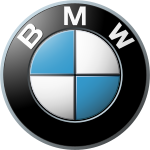1
BMW was established as a business entity following a restructuring of the aircraft manufacturing firm in 1917.
After the end of World War I
in 1918, BMW was forced to cease aircraft-engine production by the terms of the
Versailles
Armistice Treaty.
The company
consequently shifted to motorcycle production as the restrictions of the treaty
started to be lifted in 1923, followed by
automobiles in 1928–29.
The first car which BMW successfully produced and the car which launched BMW
on the road to automobile production was the Dixi, it was based on the Austin 7 and licensed from the Austin Motor
Company in Birmingham, England.


1902-1909

1909-1916

1916-1926

1926-current

1980-current


Logo history

1902-1909

1909-1916

1916-1926

1926-current

1980-current

1990-current
Mercedes-Benz traces its origins to Karl Benz's creation of the first petrol-powered car, the Benz Patent Motorwagen, financed by Bertha Benz[2] and patented in
January 1886,[3] and Gottlieb Daimler and
engineer Wilhelm
Maybach's conversion of a stagecoach by the addition of a petrol engine
later that year. The Mercedes automobile was first marketed in 1901
by Daimler-Motoren-Gesellschaft. The first Mercedes-Benz brand name vehicles were produced
in 1926, following the merger of Karl Benz's and Gottlieb Daimler's companies
into the Daimler-Benz company.[3][4]
Throughout the 1930s, Mercedes-Benz produced the 770 model, a car that was popular during
Germany's Nazi period. Adolf Hitler was known to
have driven these cars during his time in power, with bulletproof windshields. Most of
the surviving models have been sold at auctions to private buyers. One of them
is currently on display at the War Museum in Ottawa, Ontario. Mercedes-Benz has introduced many
technological and safety innovations that later
became common in other vehicles.[5]
Mercedes-Benz is one of the best-known and established automotive brands in the
world, and is also one of the world's oldest automotive brand still in existence
today in 2015, having produced the first petrol-powered car


